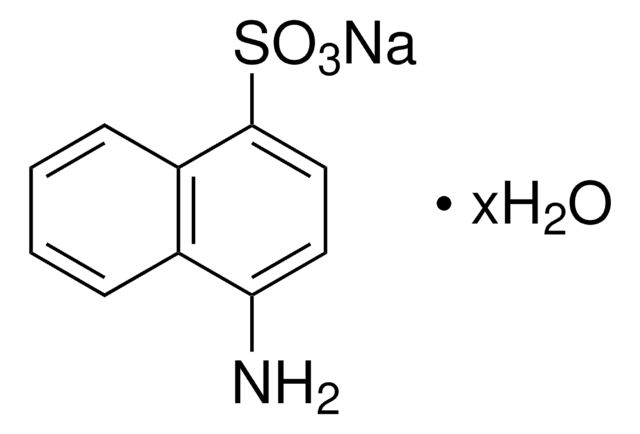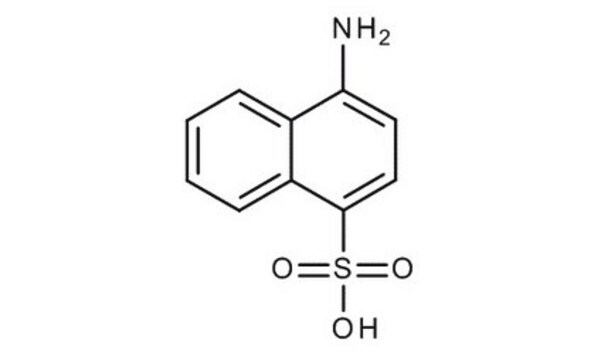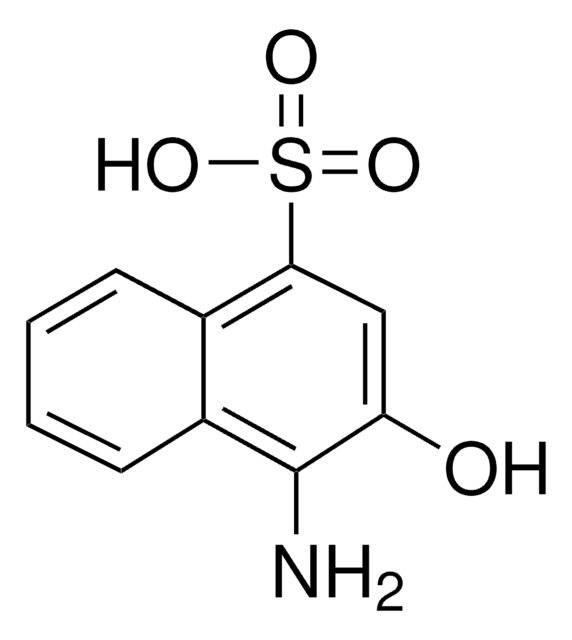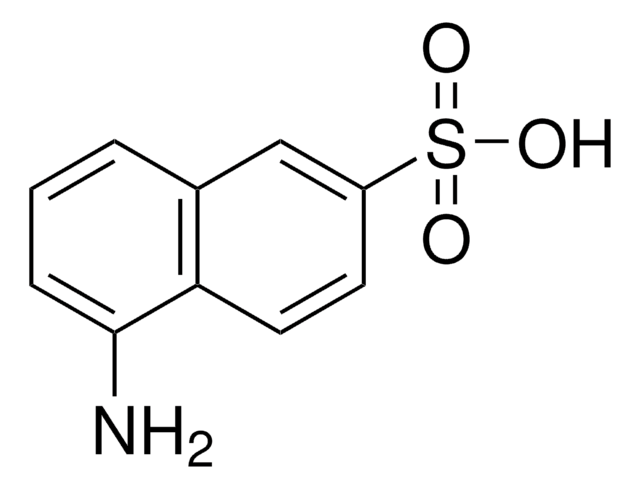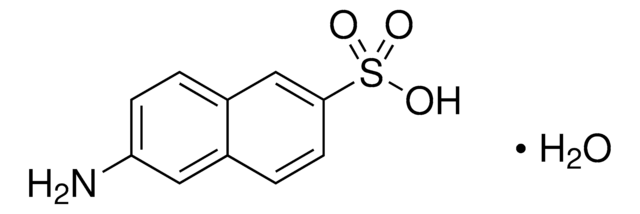250619
4-Amino-1-naphthalenesulfonic acid
97%
Synonym(s):
1-Naphthylamine-4-sulfonic acid, Naphthionic acid
Sign Into View Organizational & Contract Pricing
All Photos(1)
About This Item
Linear Formula:
H2NC10H6SO3H
CAS Number:
Molecular Weight:
223.25
Beilstein:
1971299
EC Number:
MDL number:
UNSPSC Code:
12352100
PubChem Substance ID:
NACRES:
NA.22
Recommended Products
Quality Level
Assay
97%
form
powder
mp
≥300 °C (lit.)
solubility
water: very slightly soluble(lit.)
functional group
sulfonic acid
SMILES string
Nc1ccc(c2ccccc12)S(O)(=O)=O
InChI
1S/C10H9NO3S/c11-9-5-6-10(15(12,13)14)8-4-2-1-3-7(8)9/h1-6H,11H2,(H,12,13,14)
InChI key
NRZRRZAVMCAKEP-UHFFFAOYSA-N
Looking for similar products? Visit Product Comparison Guide
General description
4-Amino-1-naphthalenesulfonic acid is a diazo compound. It is also known as Piria′s acid.
Application
4-Amino-1-naphthalenesulfonic acid has potent therapeutic applications. Its sodium salt has been used as non-toxic hemostatic.
Signal Word
Danger
Hazard Statements
Precautionary Statements
Hazard Classifications
Skin Corr. 1B
Storage Class Code
8A - Combustible corrosive hazardous materials
WGK
WGK 3
Flash Point(F)
Not applicable
Flash Point(C)
Not applicable
Personal Protective Equipment
dust mask type N95 (US), Eyeshields, Gloves
Choose from one of the most recent versions:
Already Own This Product?
Find documentation for the products that you have recently purchased in the Document Library.
Elaheh Sajadi et al.
Bioprocess and biosystems engineering, 42(12), 2023-2034 (2019-09-07)
Based on cellulose biosynthesis pathway of Gluconacetobacterxylinus BPR2001 and E. coli Nissle 1917, bcsA and bcsB genes have been selected and bioinformatics studies done to the analyses of nucleotide and amino acid sequence alignment, stability of RNA, protein, and promotor
I Lindh et al.
Rapid communications in mass spectrometry : RCM, 8(10), 797-803 (1994-10-01)
A series of small peptides has been studied by negative-ion fast-atom bombardment mass spectrometry with collision-induced dissociation. It has been found that by derivatizing peptides with 4-aminonaphthalenesulphonic acid in a peptide linkage at the C-terminus, negative-ion formation can be enhanced
David E Lefebvre et al.
Food and chemical toxicology : an international journal published for the British Industrial Biological Research Association, 110, 395-401 (2017-11-07)
The chemical amaranth (AM) is permitted as a colouring agent in a variety of foods. Safety was established based on chronic rodent studies. AM and its metabolite naphthionic acid (NA) can be absorbed through the intestine, exposing circulating immune cells
Tracing polar benzene-and naphthalenesulfonates in untreated industrial effluents and water treatment works by ion-pair chromatography-fluorescence and electrospray-mass spectrometry.
Alonso MC and Barcelo D.
Analytica Chimica Acta, 400(1), 211-231 (1999)
Circulating naphthionic acid in nonpregnant and pregnant rats after feeding amaranth.
R F Willes et al.
Toxicology and applied pharmacology, 54(2), 276-284 (1980-06-30)
Our team of scientists has experience in all areas of research including Life Science, Material Science, Chemical Synthesis, Chromatography, Analytical and many others.
Contact Technical Service